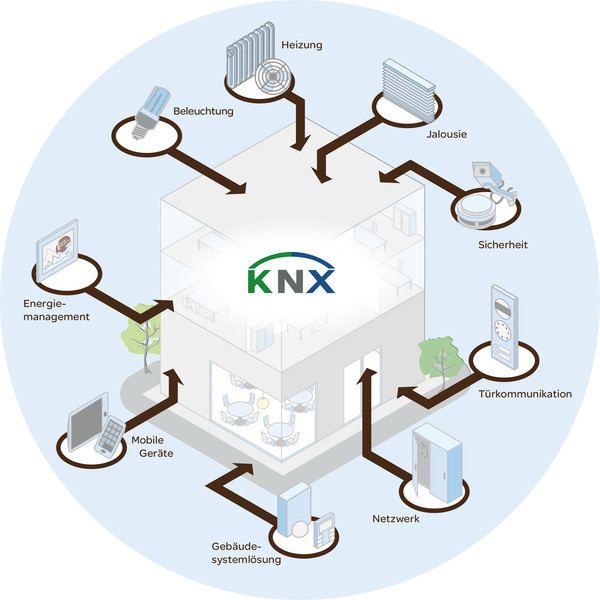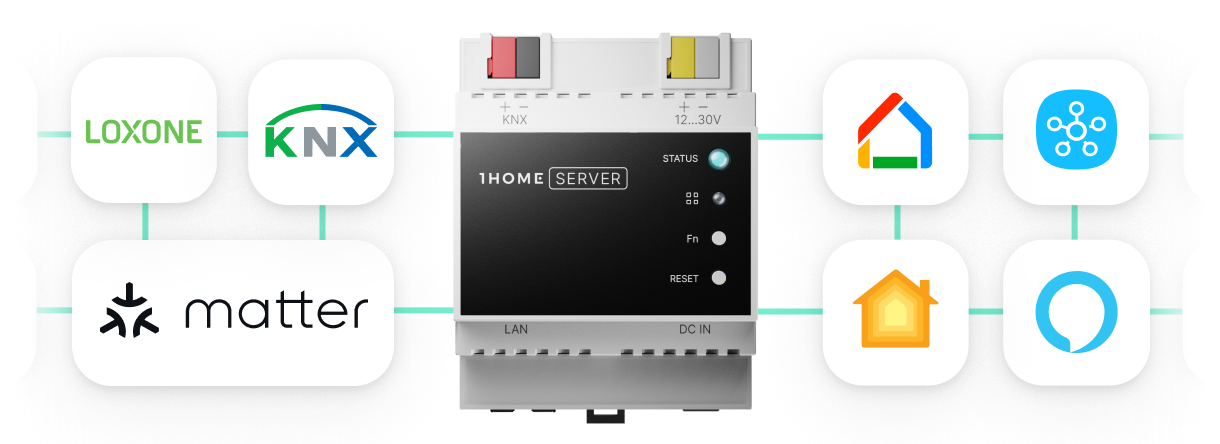
Smart home bus systems make our home more cost-effective, safer, flexible and—above all—more comfortable to live in. The largest market share of the bus based smart home systems market is occupied by the KNX standard.
Let us explain what it is and why you might choose it for your own home.
KNX - what is it?
KNX domotics is a bus system that uses a KNX standard for wired home automation and building automation. It was established in 1999 and describes how each sensor and actor can communicate with each other. It means that all devices in the KNX system are able to exchange data via a common bus network.
The KNX standard is owned and controlled by the KNX Association that unifies more than 400 companies and regularly holds KNX trainings. This year KNX is celebrating its 30th anniversary and honoring it with the biggest smart home online event on October the 20th. Save the date and celebrate that #KNXis30.

Connected home: Bus technology
The need for a centrally connected home came from the human need to stay connected. To have centralized control of your whole home and have the power to check the current status of any device at any given time. The KNX solution was perfectly timed, slightly ahead of its time and prepared to elevate building control to another level.
The development of the rest of the technology urged for the domotics and electrical installations in buildings needed to catch up. Actuators and different types of sensors were a standard feature of cars and motors, but before KNX, not yet in buildings, be it residential or commercial.

The key to making your home smarter is to link all sensors and actuators with a cable that is able to transmit communication in a fast and reliable way. There are several bus technologies out there, but no other system is supported by as many manufacturers as KNX. A KNX system was first used on commercial buildings only and is well adapted for big installations of 50.000 and more devices.
In practice, a KNX installation is prepared and maintained by a certified installer that also provides you with your home’s ETS project file with all your devices and how they connect to each other.
KNX as a standard
KNX is a smart home technology standard that was designed in the 1990s and is celebrating its 30th anniversary this year. The test of time has proven that KNX technology remains the most stable, reliable and scalable home commercial and residential building automation system. It uses a single twisted-pair (TP) cable to network every KNX device as well as supply them with power.
Low baud rate of the KNX bus: good or bad?
The KNX bus runs at a relatively low baud rate (9600bps), especially if you compare it to today’s systems which deliver information at a much higher rate, which however requires that the cable length is reduced. This is because the higher the baud rate, the more sensitive the cables become to twisting and turning around each device.
This is where KNX shines, since the KNX bus lets you use long cables, flexible topology, allows for fast communication, and at the same time reduces electricity consumption of the devices connected to it. Since you can split a KNX system into separate independent lines and areas, where each one supports over 50 telegrams per second, the communication via KNX cable is fast enough for the whole building.
There is a limit to the length of cables, however. A device can be a maximum of 350m from its power supply and the maximum length of the KNX bus cable in a single is 1000m. Each line can have up to 256 devices, but since each line can always be expanded, so with some strategy and knowledge of KNX topology, no building is too big to accommodate a KNX control system.
Taking into account the lower power consumption, long cables, fast communication and free topology, we can conclude that picking KNX for your smart home is a no brainer. Slightly lower baud rate is but an attribute that enables longer wiring around the house.
KNX IP Router
As a part of the regular KNX growth and due to the need for network connectivity, the KNX IP router was developed. The IP router lets you use the low cost, high-bandwidth medium of Ethernet that is then used in both residential or commercial buildings to send and receive KNX telegrams. The KNX IP Router has a filter table and thus contributes to reducing the bus load.
For connecting the bus with the Ethernet network, the KNXnet/IP protocol is used for communication. The use of Ethernet takes KNX domotica to the next level and due to their different characteristics, KNX and Ethernet complement each other very well.
The KNX IP router enables an interface between the IP (Ethernet) and KNX, and can also be used as a programming interface for the ETS. The KNX IP router can also be used as an area or line coupler.
The main selling point for the KNX IP router is the fact that your KNX bus can then be accessed from any point in the LAN, enabling you to integrate third-party KNX extensions such as 1Home.
Since IP/LAN supports higher transmission speeds, it can fully replace the KNX bus with its low bandwidth. The biggest perk of KNX over LAN is the fact that you can expand it in a linear, star or tree structure, whereas LAN would require a switch at every crossover point.
The KNX cable is great for local control, while LAN complements it when it comes to connecting multiple buildings together. A combination of LAN and KNX TP duct grade cable is the optimal solution for future building automation systems.
Remote Access
Since you have KNX IP technology implemented (most homes nowadays do), you can remotely connect to your home to check on device status or control any of the devices. This is enabled by the remote access that connects either via port forwarding, or more securely (since KNX doesn’t use a username/password to secure access), via a VPN tunnel or specialised devices such as Gira S1 or 1Home Bridge.
This allows you to establish a secure, encrypted remote connection between your local network and an external network. Connecting externally in a secure way has proven to be one of the biggest advantages for KNX professionals. Since they sometimes need to make some changes in the ETS project file or adapt a KNX device, they can connect remotely with no need for an extra on-site visit, and thus be more efficient.
Connect wired and wireless
We’ve shown that if you combine the speed and flexibility that IP brings, with the reliability and simplicity of the KNX bus, you have a very powerful, flexible and future proof system.
Once KNX is connected to the network, you can both monitor and control KNX devices via computers and phones. This can be done both remotely or locally, inside your home WiFi. For multimedia applications or adding third-party wireless systems that aren’t connected to the KNX bus directly, it’s a no brainer to take advantage of the KNX IP router.
One of the systems that either takes advantage of the KNX IP router or provides it for you (in case you don’t have the IP yet) is 1Home. We extend your existing KNX home with smart assistants and bring you the benefits of connecting wired and wireless and controlling all the devices as they were made by a single manufacturer. Command your smart home with voice control, create geofencing automations and securely access your home from anywhere.
---
If you have any questions regarding the IP Router, Remote Access, or are simply contemplating KNX as a standard for your home, don’t hesitate to reach out to our expert support team at support@1home.io.
Your new all-in-one KNX / Loxone Server.

